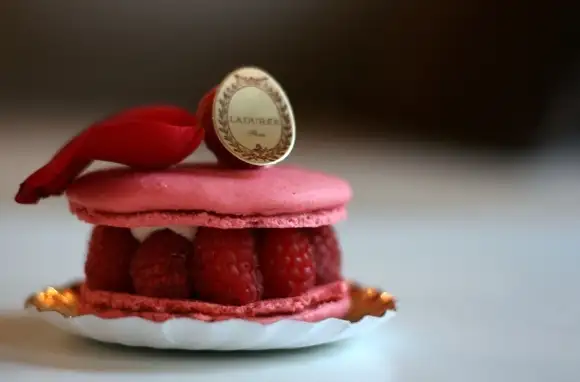
I confess. I’ve been leading a double life: Travel editor by day and pastry chef at night. For the past year, I’ve split my time between the office and culinary school, breaking only to dust the sugar off my clothes. Since my training focuses on classical French pastry, I thought it was only fitting to combine my two biggest passions with a visit to Paris (and to as many patisseries as I could squeeze into one week) over spring break. The experience was too sweet not to share.
Here are some luscious photos, along with dessert-worthy descriptions, from some of my favorite pastry shops on both sides of the Seine. Many of these gourmet boutiques are time-tested, respecting l’ancienne tradition, while others aim to innovate by creating new twists on Parisian classics. In all cases, their interiors are as much works of art as the treats on display, and I hope you find them as inspiring as I do.
Image Gallery
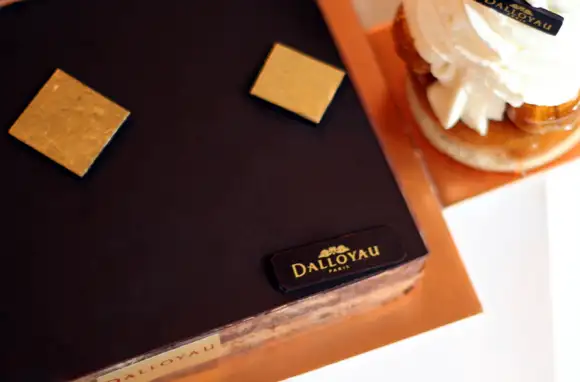
Dalloyau
I was led to this "French House of Gastronomy" by my chef instructor, Master Patissier Delphin Gomes. Before I left for Paris, he said to me, imperatively and repeatedly (as you'd expect from a French chef), "Go to Dalloyau. It's where I used to work … it's the best!" Of course. Officially founded in 1802, this pastry shop has roots that date back 300 years to the court of Versailles. Though there are now many locations, I headed to the original on rue du Faubourg Saint-Honore (a street coincidentally named for the patron saint of bakers), passing the presidential residence of Elysee Palace and endless rows of upscale boutiques. Like the surrounding neighborhood, the shop was fit for royalty (and presidents).
But what left me starstruck were the pastry cases housing what appeared to be my entire course curriculum. From chocolate-raspberry Mogador cakes to pate a choux crowned with Chantilly cream, lesson after lesson came to life. Wanting to bring something back for class, I settled on the shop's signature dessert, the Gateau Opera, made famous in Paris by Dalloyau and at The Cambridge School of Culinary Arts by Chef Delphin, who asserts that it is "no good" unless it's practically blackened with coffee syrup. (He won't let anyone—including me—live it down if they fail to drench sufficiently.)
When I presented him with the cake—stacked with joconde coffee biscuit, coffee cream, and dark chocolate ganache—his eyes went directly to the precise, laser-beam-like layers. With a wry smile and raised brow, he said to me, "See, look at how dark it is here; it's perfect." I couldn't disagree.

Dalloyau
I was led to this "French House of Gastronomy" by my chef instructor, Master Patissier Delphin Gomes. Before I left for Paris, he said to me, imperatively and repeatedly (as you'd expect from a French chef), "Go to Dalloyau. It's where I used to work … it's the best!" Of course. Officially founded in 1802, this pastry shop has roots that date back 300 years to the court of Versailles. Though there are now many locations, I headed to the original on rue du Faubourg Saint-Honore (a street coincidentally named for the patron saint of bakers), passing the presidential residence of Elysee Palace and endless rows of upscale boutiques. Like the surrounding neighborhood, the shop was fit for royalty (and presidents).
But what left me starstruck were the pastry cases housing what appeared to be my entire course curriculum. From chocolate-raspberry Mogador cakes to pate a choux crowned with Chantilly cream, lesson after lesson came to life. Wanting to bring something back for class, I settled on the shop's signature dessert, the Gateau Opera, made famous in Paris by Dalloyau and at The Cambridge School of Culinary Arts by Chef Delphin, who asserts that it is "no good" unless it's practically blackened with coffee syrup. (He won't let anyone—including me—live it down if they fail to drench sufficiently.)
When I presented him with the cake—stacked with joconde coffee biscuit, coffee cream, and dark chocolate ganache—his eyes went directly to the precise, laser-beam-like layers. With a wry smile and raised brow, he said to me, "See, look at how dark it is here; it's perfect." I couldn't disagree.
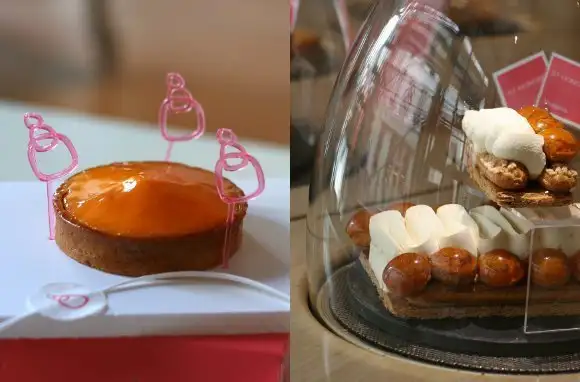
La Patisserie Des Reves
Streamlined and futuristic like an Apple Store but styled like a Candy Land IKEA, La Patisserie des Reves ("the pastry shop of dreams") at 93 rue du Bac has been capturing the sweet-toothed imaginations of visitors to Paris' 7th arrondissement since 2009. Unlike other shops, where countless items line the insides of large glass counters, here, Chef Philippe Conticini presents a scant collection of cloche-covered confections that appear to be suspended from the ceiling like pendant lights. He contemporizes the French classics by reducing them to their purest forms, and each pastry seems to glow under its own dome like a sugar-charged filament.
The desserts might be simple by design, but the process of choosing which to taste is anything but. On any given day, patrons (like me) circle the central display "consul," agonizing over the perfect choux puffs of the Paris-Brest or St.-Honore; the mille-feuille, layered with crisp, flaky rectangles; or the seasonal fruit tart baked with nothing but fresh puree, sugar, and cream. Thankfully, the decision of whether to buy the large or small version of each is much more straightforward: both, of course (one to bring home and the other to eat maintenant).
Like pieces of art, the day's dozen or so desserts remain showcased under glass at all times. However, once a purchase is made, shopkeepers whisk unseen into the back room to magically box another (with fanciful pink trimmings), forever preserving the suspension of disbelief in Conticini's pastry-shop reverie. A second location at 111 rue de Longchamp also offers a full-service tea salon.
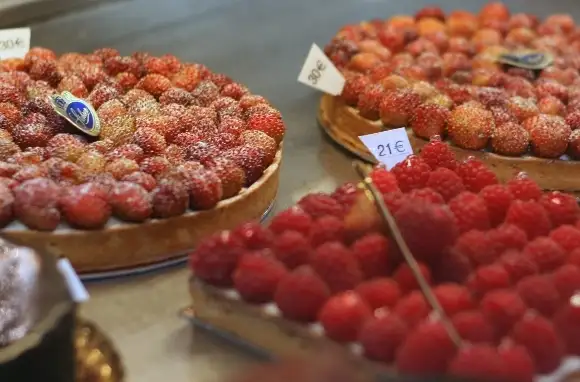
Stohrer
Pedestrian friendly and laced with many fabulous food finds, the cobblestoned rue Montorgueil in the 2nd arrondissement is, in my opinion, one of best streets to stroll (and shop) in Paris. Somewhere halfway down, between an organic boulangerie and a Basque-inspired chocolatier, sits Stohrer, the oldest patisserie in Paris. Nicolas Stohrer, the personal pastry chef for King Stanislas of Poland, came to Paris when Princess Marie Leszczynska married King Louis XV in 1725. Five years later, he opened this decadent shop on the famous market street.
Equally decadent and entrenched in history are the pastries. Before he left Poland, Stohrer invented the baba au rhum, a dry brioche originally soaked with Malaga wine and later with rum simple syrup. This yeast cake, which has many variations, is depicted in a wall mural of a sylphlike woman holding pastries (painted in 1864 by Paul Baudry, who decorated the lavish Opera Garnier). Stohrer also popularized the once-scandalous puits d'amour, or wells of love, stuffed with vanilla pastry cream and crusted with caramelized sugar. A favorite of King Louis, the cake is now sought after by lovers on Valentine's Day.
Today, the shop's opulent chandelier and gilded mirrors intensify and reflect the glow emanating from the pastries, including the glazed raspberry-chocolate tart, the chibouste (puff pastry with Calvados-flambeed apples and burnt souffle cream), the berry-filled charlotte, and the tarte aux fraises des bois, a tart shell filled with vanilla mousseline and tiny wild strawberries.
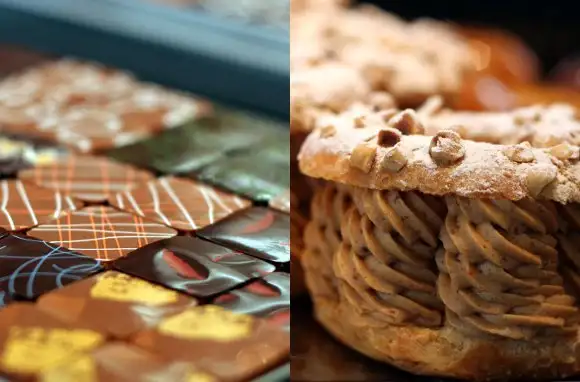
Jacques Genin
Well-known for crafting sublime confections in his workshop and supplying them to restaurants and hotels, elusive chocolatier Jacques Genin opened a storefront in 2008, giving the public direct access to his creations for the first time. The modern and lofty space, at the edge of the trendy Marais (on rue de Turenne), invites with its bright windows, exposed stonework, and a pocket of armchairs and tables positioned for prime in-house savoring.
Like a high-end jewelry store, the room's sparse design allows your eyes to float to the bursts of color inside the temperature-controlled, sweets-lined cases. By the entrance, one counter spotlights gem-like piles of pate de fruits and individually wrapped caramels, while another pulls you toward sleek arrangements of square-shaped chocolate bonbons.
I'm endlessly kicking myself for not stockpiling the mango-passion-fruit caramels, which many say are life-changing. And I would be remiss not to mention Genin's elegant individual pastries, like the long, skinny glazed chocolate eclair and the tallest Paris-Brest (a pastry ring filled with praline cream) I've ever seen. But, as predicted from a self-proclaimed "chocolate rebel" (according to The Washington Post), his chocolates defy all expectations. All have the exact same dimensions, so the focus is on the flavors—like Citron Vert (milk chocolate with lime and hazelnut) or Basilic (dark chocolate infused with fresh basil)—and each is differentiated only by the colored cocoa-butter motif on top. The shop attendants skillfully arrange the couverture candies in mosaic-like patterns inside slim metal jewel cases, which make for a very chic gift for you, or maybe someone else … maybe.
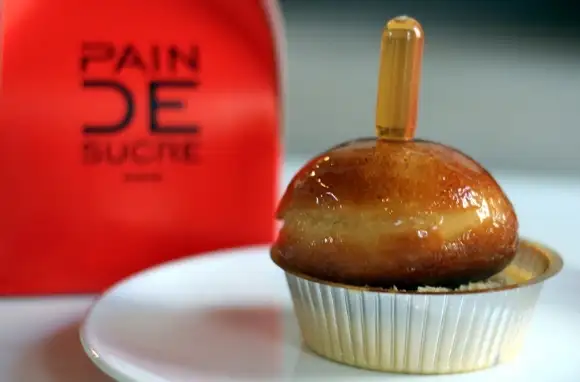
Patisserie Pain De Sucre
At 14 rue Rambuteau in the Marais, Patisserie Pain de Sucre brings new meaning to the French phrase for window-shopping: faire du leche-vitrine, which translates to "window licking." Here, upon first sight of the shop's large glass jars stuffed with pillow-like marshmallows and unusually flourished tarts, any sucrose addict will literally want to lick the window. But trust me; you'd be better off waiting until you get inside.
Since 2004, the creative chef duo of Didier Mathray and Nathalie Robert has upgraded traditional desserts with new flavor combinations, unexpected presentations, and eye-popping colors and textures, all with a touch of whimsy. Even adults will feel like kids in a candy store as they sample grown-up pralines (infused with coffee and rose), chocolate-covered guimauve on sticks, and delicate macarons. For actual kids, la chenille, made up of balls of chocolate cake, ganache, and pistachios in the shape of a caterpillar, will surely delight.
Forever seeking new inspiration as a student, I was drawn to the more eccentric sweets with unique flavors and distinctive garnishes. Imagine shortbread with rhubarb-raspberry puree, almond-orange-blossom cream, and a sprig of rosemary. Or the Maltaise, one of Les Desserts en Verres (desserts in glasses), layered with biscuit, blood-orange-grapefruit confit, and Sichuan-pepper mousse accented with caramelized fruit or a lollipop. My prize du jour? The Baobab, a pudgy, vanilla-syrup-soaked baba staked with a rum-filled pipette (you control the alcohol dose). Gimmicky, maybe, but it was perhaps the most delicious thing I ate on this trip to Paris—I'd almost go as far as to say that it was worth licking a window for.
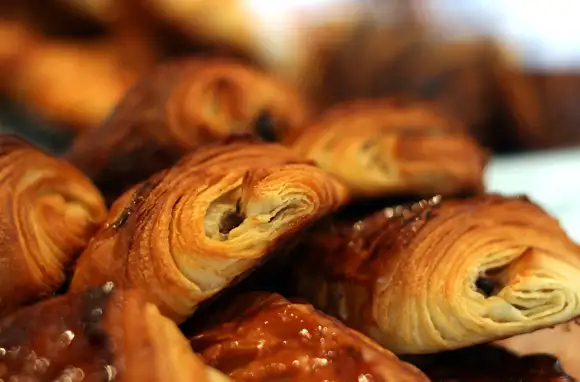
Du Pain Et Des Idees
While I visited mostly patisseries, I thought that including at least one boulangerie in my sweet escapade through Paris would be a good idea. And what better place to go than Du Pain et Des Idees, an organic bakery with a name that translates into "bread and ideas"?
Award-winning boulanger Christophe Vasseur opened this shop, at the corner of Marseille and Yves Toudic streets in the 10th, in 2002 and has risen in the bakery ranks like wildly proofing yeast dough ever since. His secret lies in making all things old—in flour and butter terms—new again. Set in a historical 19th-century building and furnished with flea-market finds, the rustic space takes you back to another era. Plus, he crafts everything using traditional methods such as making sourdough from natural starters and baking breads on a stone. With his viennoiseries, old and new intersect in the most appealing way. Find classic butter croissants but also versions incorporating rose water and matcha tea, pain au chocolat loaded with fresh bananas, and pastry-cream-filled "snails" highlighting black currant and kirsch. I snagged the seasonal apple tart with salted butter and a puff-pastry bottom so caramelized it almost formed its own dish.
On the way back to my Marais apartment, the scent drifting upwards from my bag seduced me into making a bad judgment call: nibbling at my croissant while walking through the harrowing traffic and construction at Place de la Republique, getting lost and nearly run over by a scooter in the process. Next time, I'll join the Parisians who gather at the wooden communal table outside the bakery—certainly a much better option when it comes to bread and brilliant ideas.
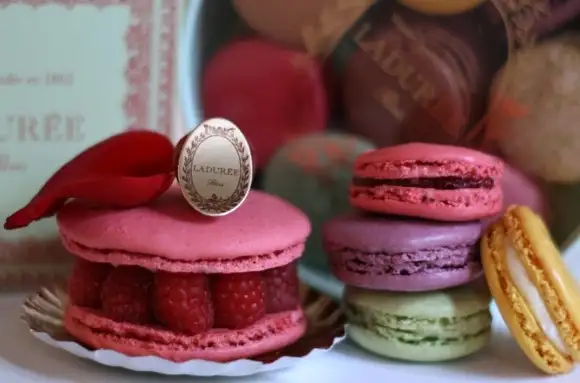
Laduree
If the 19th century had the equivalent of a cupcake craze, it would be the French macarons at Laduree. These dainty, almond-meringue gerbets sandwiched around layers of flavored ganache are sweet and beautiful, come in pastel colors, and attract women in droves. Founded in 1862 by Louis Ernest Laduree, the original bakery at 16 rue Royale took its place among the other luxurious shops in and around Place de la Madeleine. But leave it to a smart, trendsetting woman to reinvent it. Sometime after the original bakery burned down, Laduree's wife, Jeanne Souchard, turned the shop into both a patisserie and one of the first tea salons in Paris, giving ladies a place to gather publically. And do they ever gather, even today (just observe the line that snakes around the shop and well onto the sidewalk outside).
Inside, belle choses coat every inch: Frescoes of gourmet cherubs by painter Jules Cheret adorn the ceiling, delectable desserts flirt from inside the extended counter, and signature celadon boxes on shelves beckon to be packed, gracefully, one macaron at a time. The first Paris macaron (invented in the 20th century by Pierre Desfontaines, a distant cousin to Laduree) came in flavors like vanilla, chocolate, and coffee, and the list of favorites has expanded to include caramel with salted butter, pistachio, lemon, and raspberry. Current Pastry Chef Philippe Andrieu stays ever en vogue by adding new seasonal editions; while I was there in spring, it was cherry blossom.
Other classics—like the violet Religieuse (two cream puffs dressed to resemble a nun), the Ispahan (a rose macaron with fresh raspberries and lychee), and even special 150th Anniversary pastries—will also appeal to anyone's feminine side. Laduree currently has several boutiques, including another tearoom on the Champs-Elysees.
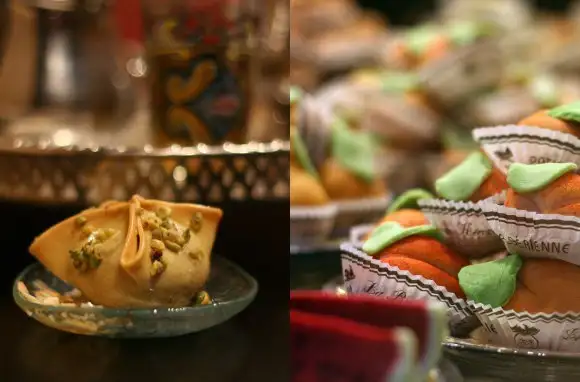
La Bague De Kenza
One of my favorite things about Paris is that, if you know where to look, you can find culinary treasures that celebrate influences from other cultures. Case in point: the Algerian pastries at La Bague de Kenza. The shop's name, which translates to "The Ring of Kenza," came about after one of the owners lost and then later found his daughter's ring (or so the story goes). But with eight locations in Paris, you won't have to get too lost to discover all "B.K." has to offer.
And lucky for me. During a spring downpour, I happened to be near the pastry shop and tea salon at 136 rue Saint-Honore, and warmed up inside with sweetened mint tea (served in a silver pot) and a tagine of vegetable couscous. After that, it was time to sample patisserie orientale such as the Pochette Pistache, a small purse of dough enclosing a mixture of honey and chopped pistachios. Rainy-day perfection.
Partners Samira Fahim and L'Hassen Rahmani created La Bague de Kenza about 15 years ago and continue to expand—with good reason. According to a New York Times article, it has been trendy in recent years for Parisians to bring a box of baked goods from Kenza when invited to someone's home. Not only do the pastries refrain from being overly sweet, but they have a gourmet quality and are exquisitely beautiful as well. Upon entering the shop, prepare to be entranced by trays of bite-sized desserts in paper wrappings. Picture mounds of almond crescents (tcharek ariane); baked makrouts, traditional Algerian semolina cookies with date paste; herisson aux pignons, little pine-nut-coated cakes that resemble hedgehogs; and especially hard to miss, the marzipans, shaped and colored like sliced watermelons, peaches, and other fruits. You might not know what anything is, but just point to whatever looks delicious and give it a try. You're sure to find something to love and will inevitably get lost in the moment.
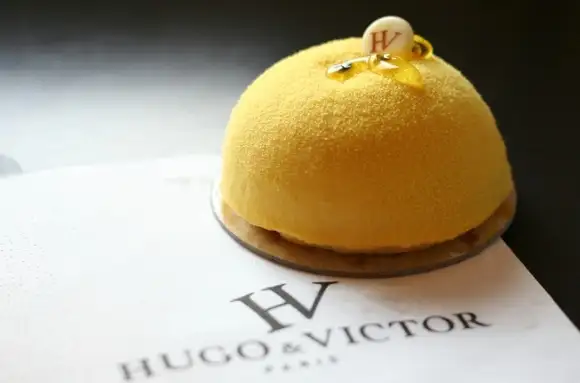
Hugo & Victor
Your pick: Hugo or Victor? One daring, the other classic. The good news is that both are genius. At the "haute" patisserie Hugo & Victor, started by two childhood friends, Pastry Chef Hugues Pouget and business partner Sylvain Blanc, good things seem to come in twos. Each pastry, based on chocolate, vanilla, caramel, or one of several seasonal flavors, has two variations: the traditional "Victor" and its deconstructed "Hugo" counterpart. Appealing to my wilder side, the bombe-shaped Hugo Passion, made with spongy white cake and intensely tart passion-fruit mousse and gelee, became my dessert of choice (the Victor Passion is a more simply designed triangle layer cake). Either way, all the masterful delicacies are displayed (and labeled) like objets d'art set behind recessed museum glass. I took my time in the "gallery," critically contemplating each item before making my careful selection.
The store's minimalist black-and-white decor offsets floor cabinets exhibiting tantalizing chocolates that mimic the pastries' flavor profiles; these dazzling half-spheres are boxed in hollow Moleskine books to honor Paris' literary past. Like all masterpieces, everything here is crafted with superior attention to detail, and the medium is of prime importance: Pouget sources his vanilla from a single Tahitian producer who grows on three specific island terroirs, and some fruits are harvested solely for the shop. Whether you prefer Pouget's individual pastries, chocolate bonbons, or other specialties, like the award-winning, cake-like financiers, style and sourcing always go hand-in-hand, just like Hugo and Victor.
And for the ultimate pairing, there's a shop for each side of the Seine, one on the Left Bank at 40 Boulevard Raspail and one on the Right on 7 rue Gomboust.
What's your favorite pastry shop in Paris?
You Might Also Like:
We hand-pick everything we recommend and select items through testing and reviews. Some products are sent to us free of charge with no incentive to offer a favorable review. We offer our unbiased opinions and do not accept compensation to review products. All items are in stock and prices are accurate at the time of publication. If you buy something through our links, we may earn a commission.
Top Fares From
Today's Top Travel Deals
Brought to you by ShermansTravel
Kenya: 14-Night Tour, Incl. Tanzania &...
smarTours
 vacation
$7125+
vacation
$7125+
7-Night Caribbean Round-Trip Cruise From Orlando:...
Norwegian Cruise Line
 cruise
$739+
cruise
$739+
Ohio: Daily Car Rentals from Cincinnati
85OFF.com
 Car Rental
$19+
Car Rental
$19+



